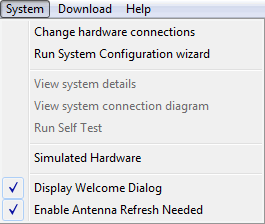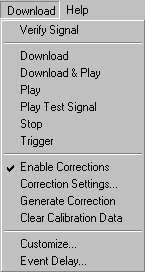Open topic with navigation
Frequency Agile Program Example
The Frequency Agile program generates a signal with a single pattern consisting of three pulses. Each of the pulses use different Pulse Type definitions. The first pulse, CW1, is created using the Pulse Building application's trapezoidal definition. The second pulse, CW2, uses a custom I/Q format to describe the trapezoidal pulse type. The third pulse, CW3, uses a custom profile format to describe the pulse. This program example creates the signal generated in the Frequency Agile Example shown in the Examples section of this Help system and uses the same parameters. Review this example for a description and details on the settings and parameters used to generate the signal. The Frequency Agile program will:
-
Build a pattern of pulses
-
Use pattern parameter properties such as repeats, edge jitter, and so forth
-
Set the signal generator power level and frequency
-
Generate three pulses with different frequency offset values
-
Use the power scale function to scale the amplitude of the third pulse
-
Read I/Q and custom profile data from a text file
Each of the forms that make up this program example is discussed in the following sections:
Details on procedures and declarations include:
Pulse Building Form
The Pulse Building form is the first form displayed when the program is run. The Connect to Instrument  button on this form starts the Run System Configuration wizard. This wizard allows you to change or create a hardware configuration and select a GPIB or LAN (TCP/IP) connection for I/O instrument communication. You can also access the wizard from the
button on this form starts the Run System Configuration wizard. This wizard allows you to change or create a hardware configuration and select a GPIB or LAN (TCP/IP) connection for I/O instrument communication. You can also access the wizard from the  System menu. In addition to the Connect to Instrument button, the Pulse Building form has a Download and Play
System menu. In addition to the Connect to Instrument button, the Pulse Building form has a Download and Play  command button that will generate a waveform, download the waveform, marker, and sequence files to the signal generator, and play the corrected waveform.
command button that will generate a waveform, download the waveform, marker, and sequence files to the signal generator, and play the corrected waveform.
The Frequency Agile example uses file input to read data from text files. Select the Microsoft Scripting Runtime library from the Available References in your Visual Basic project. You must reference this library.
A check mark beside Enable Corrections on the  Download menu indicates that corrections are applied to the signal. The corrections used are RF Flatness and Image Rejection. You must have an analyzer connected to the signal generator if you want to use corrections. To save the .pbp file in the directory where the Menu Driven Test program is run click the Save button
Download menu indicates that corrections are applied to the signal. The corrections used are RF Flatness and Image Rejection. You must have an analyzer connected to the signal generator if you want to use corrections. To save the .pbp file in the directory where the Menu Driven Test program is run click the Save button  or select . This .pbp file consists of the Pulse and Pattern Library items along with all associated parameters.
or select . This .pbp file consists of the Pulse and Pattern Library items along with all associated parameters.
You must have a spectrum or signal analyzer connected to the signal generator if you want to use corrections.
General Section
The following code listing is from the Pulse Building form's General section. Descriptions follow the code lines.
Option Explicit '
Dim project As AgtPBProject '
Dim cw1 As AgtPBPulse '
Dim cw2 As AgtPBPulse '
Dim cw3 As AgtPBPulse '
Dim AgilePattern As AgtPBPattern '
Dim AgileItem As AgtPBPatternItem'
Dim SpectrumAnalyzer As AgtPBSpectrumAnalyzer '
Dim SignalGenerator As AgtPBSignalGenerator '
Dim Settings As AgtPBSignalProperties '
Dim IData() As Double '
Dim QData() As Double '
Dim customProfile() As Double '
Dim dataType As String '
Dim SGConnected As Boolean '
Dim SAConnected As Boolean '
Form Load Event
The following code listing is from the Pulse Building form'sForm_Load() event. Functions and code descriptions follow or precede the code statements.
Private Sub Form_Load()
On Error GoTo Error_Handler '
Set project = New AgtPBProject '
Exit Sub
Error_Handler:
MsgBox Err.Description
End Sub
cmdRun Event
The following code listing is from the Pulse Building form'scmdRun_Click() event. The program creates three pulses; CW1, CW2, and CW3. These three pulses are used to create a pattern named AgilePatternComments describing functions follow or precede code statements.
Private Sub cmdRun_Click()
On Error GoTo ErrorHandler '
If Not SGConnected Then '
Call MsgBox("Connect Signal Generator", vbOKOnly)
frmMain.MousePointer = vbDefault
Exit Sub
End If
If Not SAConnected And chkCorrections.Value = 1 Then '
Call MsgBox("Connect Spectrum Analyzer", vbOKOnly)
frmMain.MousePointer = vbDefault
Exit Sub
End If
frmMain.MousePointer = vbHourglass '
cmdRun.Enabled = False '
project.NewProject ("Frequency Agile Pulse.pbp") '
'
Set cw1 = project.PulseLibrary.CreateNewPulse("CW1") '
cw1.PulseType = AgtPBPulseType_Trapezoidal '
'
'
Call cw1.SetEnvelopeTrapezoidal(0.00000003, 0.00000003, 0.00000094, AgtPBJitterType_Gaussian, 0.0000001)
cw1.ModulationType = AgtPBModulationType_FMChirp '
'
Call cw1.SetModulationFMChirp(5000000, AgtPBFMChirpDeviationType_Ascending) '
dataType = "IQ" '
Call ReadDataASCIIFile(IData(), QData(), customProfile(), dataType) '
'
Set cw2 = project.PulseLibrary.CreateNewPulse("CW2") '
cw2.PulseType = AgtPBPulseType_CustomIQ '
'
Call cw2.SetCustomIQ(100000000, IData(), QData())
cw2.ModulationType = AgtPBModulationType_None '
'
Set cw3 = project.PulseLibrary.CreateNewPulse("CW3") '
cw3.PulseType = AgtPBPulseType_CustomEnvelope '
dataType = "Custom" '
Call ReadDataASCIIFile(IData(), QData(), customProfile(), dataType) '
'
Call cw3.SetEnvelopeCustom(100000000, customProfile())
cw3.ModulationType = AgtPBModulationType_FMChirp '
'
Call cw3.SetModulationFMChirp(5000000, AgtPBFMChirpDeviationType_Ascending)
'
Set AgilePattern = project.PatternLibrary.CreateNewPattern("Frequency Agile")
'
Set AgileItem = AgilePattern.CreateNewItemAt(AgtPBPatternItemObjectType_Pulse, "CW1", 0)
'
AgileItem.RepetitionIntervalSec = 0.000003 '
AgileItem.NumberOfRepeats = 1 '
AgileItem.EdgeJitterType = AgtPBJitterType_None '
AgileItem.JitterDeviationSec = 0 '
AgileItem.RelativePowerScaleDB = 0 '
AgileItem.FrequencyOffsetHz = -10000000 '
AgileItem.PhaseOffsetRad = 0 '
'
Set AgileItem = AgilePattern.CreateNewItemAt(AgtPBPatternItemObjectType_Pulse, "CW2", 1)
'
AgileItem.RepetitionIntervalSec = 0.000003 '
AgileItem.NumberOfRepeats = 1 '
AgileItem.EdgeJitterType = AgtPBJitterType_Gausian '
AgileItem.JitterDeviationSec = 0 '
AgileItem.RelativePowerScaleDB = 0 '
AgileItem.FrequencyOffsetHz = 0 '
AgileItem.PhaseOffsetRad = 0 '
'
Set AgileItem = AgilePattern.CreateNewItemAt(AgtPBPatternItemObjectType_Pulse, "CW3", 2)
'
AgileItem.RepetitionIntervalSec = 0.000003 '
AgileItem.NumberOfRepeats = 1 '
AgileItem.EdgeJitterType = AgtPBJitterType_None '
AgileItem.JitterDeviationSec = 0 '
AgileItem.RelativePowerScaleDB = -10 '
AgileItem.FrequencyOffsetHz = 10000000 '
AgileItem.PhaseOffsetRad = 0 '
'
If chkSaveFile.Value = 1 Then
project.SaveProject
End If
'
If chkCorrections.Value = 0 Then
project.ImageRejectionCorrectionEnabled = False
project.RFFlatnessCorrectionEnabled = False
End If
project.DownloadAndPlayPattern ("Frequency Agile") '
Call MsgBox("Signal Downloaded to Signal Generator", vbOKOnly)
frmMain.MousePointer = vbDefault '
cmdRun.Enabled = True '
Exit Sub
ErrorHandler:
frmMain.MousePointer = vbDefault '
cmdRun.Enabled = True '
Call MsgBox(Err.Description, vbOKOnly) '
End Sub
ReadDataASCIIFile Procedure
The following code listing is from the Pulse Building form'sReadDataASCIIFile() procedure. The procedure opens a text data file and reads the text data into a string array. The text files are in the following locations:
Windows 7
C:\Users\Public\Public Documents\Keysight\Pulse Building\Samples\VB6\Frequency Agile
Windows XP
C:\Documents and Settings\All Users\Keysight\Pulse Building\Samples\VB6\Frequency Agile
The IQ data file uses a tab delimited format to hold the I and Q data values describing the pulse. The custom profile data file uses single data values separated by end of line carriage returns to represent the amplitude values describing the pulse. The array data is passed back to the cmdRun() event procedure. Functions and code descriptions follow or precede the code statements.
Private Function ReadDataASCIIFile(IValues() As Double, QValues() As Double, customProfile() As Double, dataType As String)
Dim s As String '
Dim i As Integer '
Dim sArray() As String '
Dim fso As New FileSystemObject, textFile As File, ts As TextStream '
On Error GoTo FileError '
'
'
If dataType = "IQ" Then
Set textFile = fso.GetFile(App.Path & "\Freq Agile IQ.txt")
Else
Set textFile = fso.GetFile(App.Path & "\Freq Agile Custom Profile.txt")
End If
Set ts = textFile.OpenAsTextStream(ForReading) '
'
Do While Not ts.AtEndOfStream
s = ts.ReadLine '
If dataType = "IQ" Then '
ReDim Preserve IValues(i) '
ReDim Preserve QValues(i) '
sArray = Split(s, vbTab) '
IValues(i) = CDbl(sArray(0)) '
QValues(i) = CDbl(sArray(1)) '
Else '
ReDim Preserve customProfile(i)
customProfile(i) = CDbl(s) '
End If
i = i + 1 '
Loop
ts.Close '
Exit Function
FileError:
MsgBox Err.Description
End Function
Signal Generator and Spectrum Analyzer Connection Forms
The Sensitivity Program Example describes the signal generator and spectrum/signal analyzer I/O connection forms. Refer to that section for details.
Related Topics
API Programming Overview
Sensitivity Program Example
Complex Test Program Example
Executive Test Program Example
 button on this form starts the Run System Configuration wizard. This wizard allows you to change or create a hardware configuration and select a GPIB or LAN (TCP/IP) connection for I/O instrument communication. You can also access the wizard from the
button on this form starts the Run System Configuration wizard. This wizard allows you to change or create a hardware configuration and select a GPIB or LAN (TCP/IP) connection for I/O instrument communication. You can also access the wizard from the  command button that will generate a waveform, download the waveform, marker, and sequence files to the signal generator, and play the corrected waveform.
command button that will generate a waveform, download the waveform, marker, and sequence files to the signal generator, and play the corrected waveform.
 or select
or select 